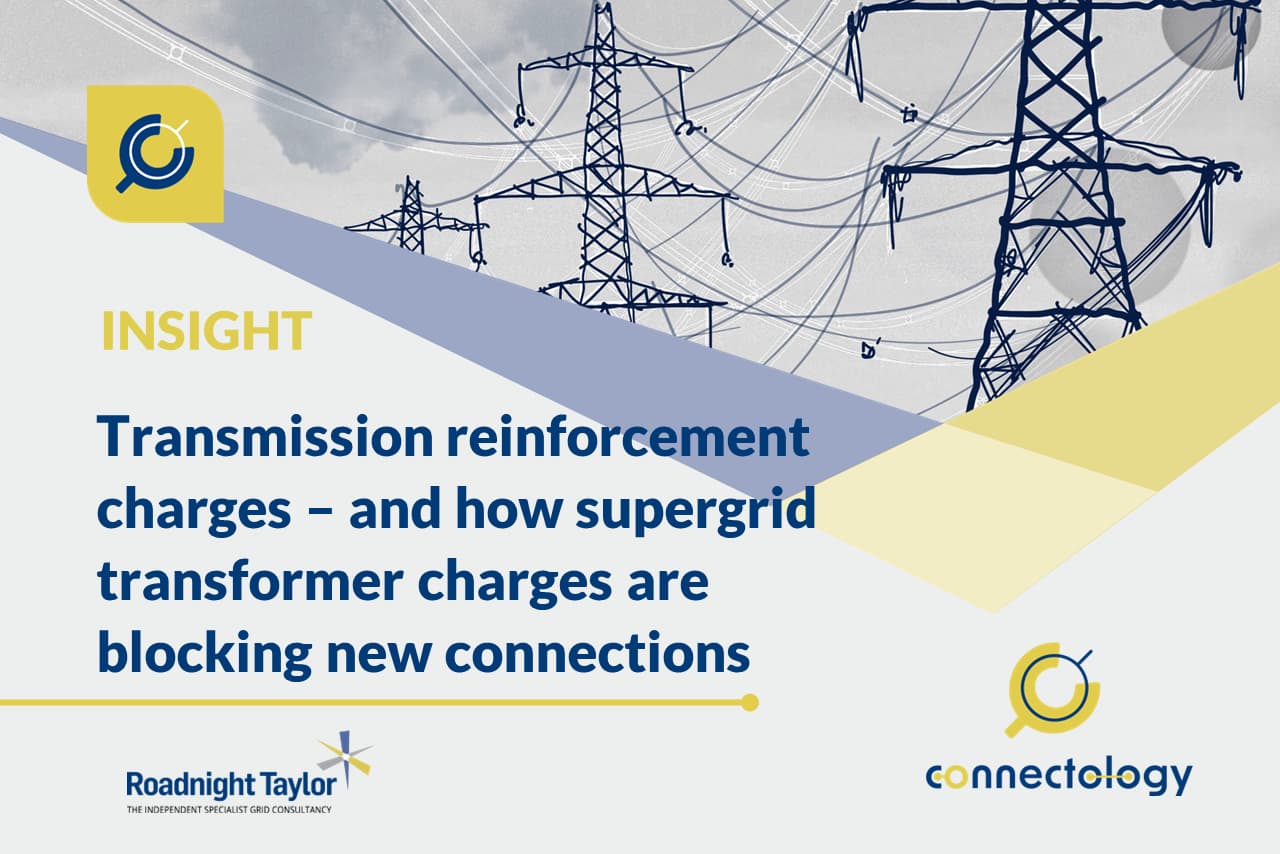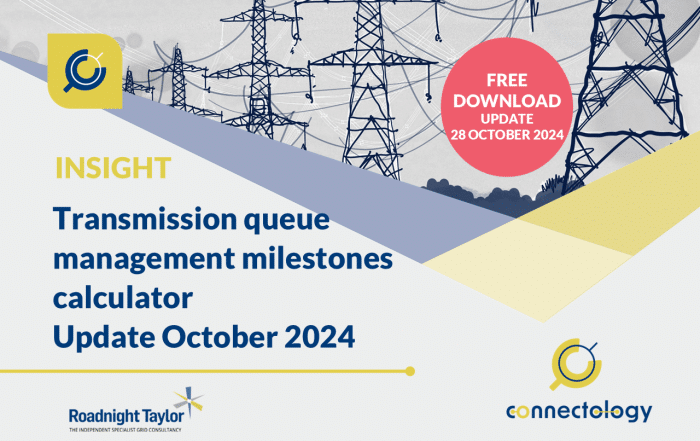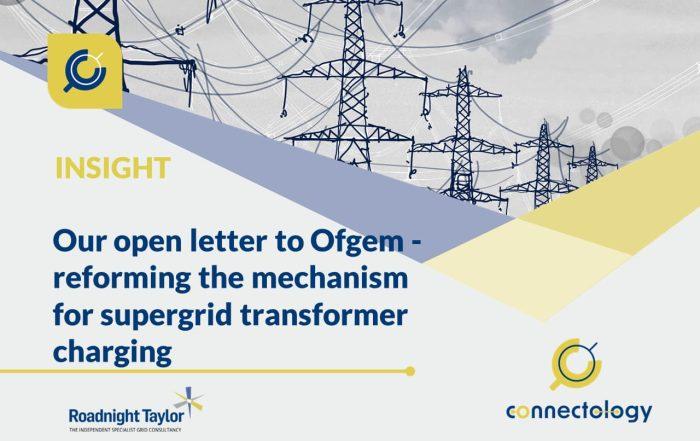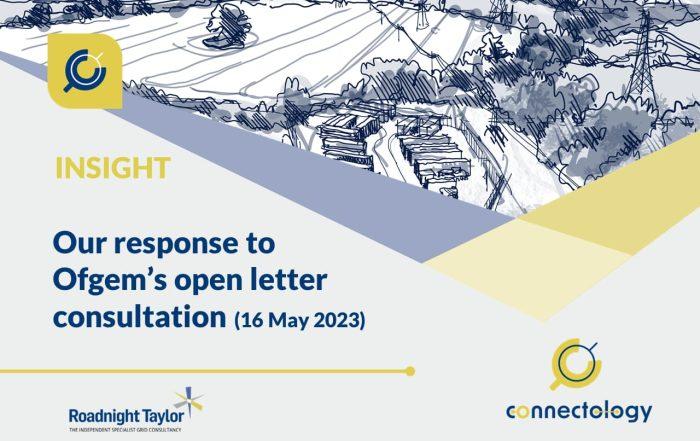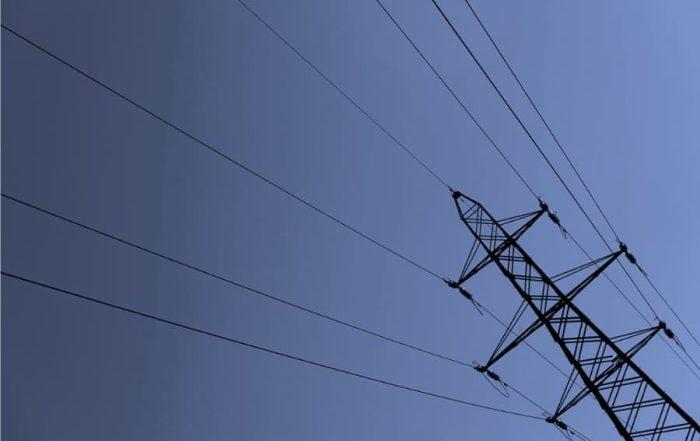Transmission reinforcement charges – and how supergrid transformer charges are blocking new connections
In one of our previous Insight articles, Catherine Cleary explained some of the differences between transmission and distribution connections. In this article, Pete Aston explains more about how reinforcement works are treated differently between transmission and distribution, and how reinforcement charging for supergrid transformers (SGTs) is a blocker to new generation connections.
Article by Pete Aston – acknowledged expert in networks
Pete joined Roadnight Taylor from Western Power Distribution, the UK’s largest DNO, where he was Primary System Design Manager. He led a team of sixty responsible for all connections to the extra high voltage network, as well as leading WPD’s interaction with National Grid (NGET and NGESO) at the transmission/distribution boundary.
31st August, 2022

Supergrid transformer reinforcement
Reinforcement works are regularly required to connect new loads to the network, whether new generators (solar, wind, hydro, etc), or new demands (housing estates, warehouses, data centres, etc).
At distribution (voltages up to and including 132kV in England and Wales, and 33kV in Scotland), reinforcement is apportioned to the triggering customer by using a Cost Apportionment Factor (CAF), based on the new rating of the network once the reinforcement has happened. Subsequent customers connecting to the network pay a second comer charge, which uses the same CAF principle. Any customer-driven reinforcement costs not collected by connections are paid for through the distribution use of system charged (DUOS), i.e. are socialised throughout the DNO region.
At transmission, reinforcements on the main interconnected network are always socialised, such that customers connecting directly to the transmission system do not pay for wider reinforcement works. The cost of the reinforcement is instead picked up by the transmission network use of system (TNUOS) charge, which gets passed on to customers directly connected to the transmission system, and is ultimately passed on to bill payers, i.e. is socialised across the whole country.
Whilst transmission customers don’t pay for reinforcements, cancellation charges and associated securities payments are required instead, such that large sums of money may be at risk if the scheme is cancelled. (In some circumstances, distribution customers are liable for such cancellation charges as well).
There is, however, one piece of the transmission network that is often paid for by connecting customers , and that is reinforcement of the SGTs. The SGTs are the interface between the transmission network and the distribution network. If connections to the distribution network trigger reinforcement of the SGTs, the cost of this reinforcement is passed onto the distribution customers who triggered it. The charge is not apportioned on the basis of the capacity of the SGT, but on the required capacity of the customers who triggered the works.
For example, if a group of 10 generation customers triggered the SGT reinforcement, with a total required export capacity of 150MW, and an SGT reinforcement cost of £12m, each MW costs £12m/150MW = £80k/MW. A 10MW scheme would therefore pick up a charge of £800k towards the work, likely making the scheme unviable.
Even worse, if any of the 10 customers pulls out, the cost for all the other customers goes up, such that one customer could end up picking up the entire £12m cost of the reinforcement.
This is not just a theoretical situation, but is happening now across the country, where large levels of embedded generation, including batteries, are triggering reinforcement of SGTs. Most developers in these situations cannot handle such a large financial risk and are unable to proceed. There are hundreds of MW of generation across the country already being written to about such charges, with more to come throughout the rest of this year and into next.
Potential solutions
The body with the power to solve this problem is Ofgem, because they are in charge of the charging rules for network companies. Ofgem has recently had opportunities to resolve this, but has decided to prioritise other matters. Firstly, Ofgem recently concluded their Significant Code Review (SCR) in relation to Access and Charging on distribution networks. In their first consultation on the SCR (summer 2021), transmission charging in relation to SGTs was included. However, by their second consultation in early 2022, they had removed this, saying they would include it in a wider review of transmission charges, which is likely to be some time into the future.
Secondly, Ofgem announced in August 2022 a consultation on accelerating onshore electricity transmission investment. However, this is focused on the larger, more strategic reinforcements of the main interconnected transmission system, in order to facilitate primarily offshore wind, and again doesn’t include SGT charging.
Ofgem’s seeming lack of willingness to address the issue is likely because it will be complex to resolve, and will be tied up with a wider reform of TNUOS. Two of the options to addressing the issue are as follows:
- Apportion costs based on a CAF, similar to distribution reinforcement. In this way, the capacity of the assets is used as the denominator to apportion the costs, rather than the capacity of the contracted schemes which triggered the work. This both leads to a lower £/MW figure and also to certainty of cost for customers, as their portion of the charge doesn’t change if other customers pull out. The downside of this is that a CAF may still represent a high charge to connections and could render many schemes unviable. The challenge for Ofgem, National Grid and the DNOs is how to fund the unrecovered portion of the reinforcement, e.g. is it recovered through TNUOS or DUOS?
- Completely socialise the charge, such that connecting customers don’t pay anything towards the reinforcement. This has the obvious advantage of reducing the cost for connecting customers, but has the downside of removing a locational charging signal and as a result causing potentially high levels of reinforcement in certain areas. Bill payers may see increased charges as a result. It does, however, give the Transmission Operators (TOs) a strong price signal for comparing costs of managing the constraints through flexibility, or undertaking conventional reinforcement. The challenge for Ofgem is again working out whether this would go into TNUOS or DUOS.
Exceptions
As ever, there is an exception to the SGT reinforcement charging principle highlight above, which is based on the classification of the site. SGTs are located at Grid Supply Points (GSPs) and there are two classifications of GSP. The standard one is called a Connection Asset site, where the GSP only supplies one customer, such as one distribution network operator (DNO). It is at these sites where the above reinforcement charging scenario occurs.
The other classification of site is an Infrastructure site, where there are two or more customers, such as two DNOs, or one DNO and a large generator. At these sites, SGT reinforcement is funded by the transmission company through TNUOS, and costs are not passed on to the distribution customers who trigger the works. It therefore can become something of a postcode lottery as to whether a connection will be charged for SGT reinforcement or not, depending on whether the site is fed by a Connection Asset GSP or by and Infrastructure GSP.
The plot thickens with a recent development in types of connection being offered by National Grid called tertiary connections. Tertiary connections are made directly into an SGT and mean that there is then another customer connected directly to the GSP. When tertiary connections are made to a Connection Asset GSP, National Grid will reclassify the site to be an Infrastructure GSP. So a site that is currently a Connection Asset site could become an Infrastructure site within the next five years or so, as tertiary connections are made across National Grid’s network. This means that sites that customers might currently avoid due to picking up potential SGT reinforcement charges, might become attractive to connect to once a tertiary connection is made. But to predict which tertiary connections will actually connect needs a crystal ball that no one currently has access to!
How we can help
SGT reinforcement charging is a complex area, one in which Roadnight Taylor is well placed to advise on. We have up to date knowledge across the country and can indicate sites that currently have been, or might be, triggered for SGT reinforcement. This issue can make or break a project and needs the expert knowledge and advice that we offer.
Contact us
To understand how SGT reinforcement charging can impact your project, call us on 01993 830571 or send us a message via our contact form.

